|
ISRAEL
July & August 1984
Vicky Blitz
We entered Israel on Friday, July 27, 1984, following a nine-hour ride through the Sinai
Desert in a dilapidated, non-air conditioned bus out of Cairo, Egypt. Passing
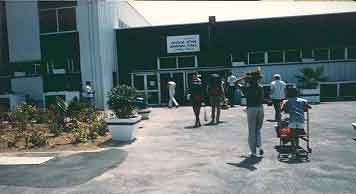 through
customs, we had our passports stamped and were given maps, and travel brochures, and a warm, welcoming smile by a lovely young Israeli woman at the
border. Our luggage was placed on a new, clean, modern, AIR-CONDITIONED bus and the first thing I did upon
arriving was to order a glass of water, which I hadn't been able to do for the past three weeks in Egypt. The building, itself, was such a contrast to the Egyptian side of the
border, with its painted floors and clean walls, and the knowledge we could now order food and drink without having to worry about coming down with the Pharaoh's Curse. We were surrounded by green grass and flowers, BEAUTIFUL flowers, in a variety of colors.. .a long time since we had seen anything like it. through
customs, we had our passports stamped and were given maps, and travel brochures, and a warm, welcoming smile by a lovely young Israeli woman at the
border. Our luggage was placed on a new, clean, modern, AIR-CONDITIONED bus and the first thing I did upon
arriving was to order a glass of water, which I hadn't been able to do for the past three weeks in Egypt. The building, itself, was such a contrast to the Egyptian side of the
border, with its painted floors and clean walls, and the knowledge we could now order food and drink without having to worry about coming down with the Pharaoh's Curse. We were surrounded by green grass and flowers, BEAUTIFUL flowers, in a variety of colors.. .a long time since we had seen anything like it.
We were still a long way from Jerusalem, but what a different landscape. Israel has reclaimed the land from the desert, planted orchards and produce, and constructed neat, painted farm buildings. The desert bloomed.. .and bloomed.. .and bloomed.
At Ashdod, we switched to a local bus and arrived in Jerusalem about 3:00 p.m. We had been on the road, out of Cairo, since 4:00
a.m., almost 24 hours. Arriving by cab at the Jerusalem Hilton, we found the lobby occupied by groups of young American
Jews who seemed to be having a wonderful time just being there.
The Hilton had confirmed our reservations while we were in Cairo and canceled them after we left. We were to meet friends, Charlie and Trudy, this evening, but the
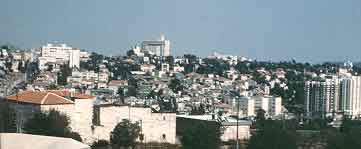 hotel clerk told us their group was in Haifa. Later we were to discover this was not true and they were in the hotel all along. Anyway, they found a little room for us and, having had no sleep since leaving Cairo, we crashed about 4:45
p.m. and slept until 9:00 p.m., when we dressed, went down to dinner and--
oops, it's Friday evening, (Sabbath) and they don't heat the grill on Sabbath. That's OK. We
hadn't had salads in three weeks, so we ordered tuna salads and they were the largest I've ever seen. They had green beans, potatoes, tuna, onions, olives, tomatoes,
anchovies, and lettuce. I also had a delicious glass of milk and about four glasses
of ice water. The salad was so large I couldn't finish it. hotel clerk told us their group was in Haifa. Later we were to discover this was not true and they were in the hotel all along. Anyway, they found a little room for us and, having had no sleep since leaving Cairo, we crashed about 4:45
p.m. and slept until 9:00 p.m., when we dressed, went down to dinner and--
oops, it's Friday evening, (Sabbath) and they don't heat the grill on Sabbath. That's OK. We
hadn't had salads in three weeks, so we ordered tuna salads and they were the largest I've ever seen. They had green beans, potatoes, tuna, onions, olives, tomatoes,
anchovies, and lettuce. I also had a delicious glass of milk and about four glasses
of ice water. The salad was so large I couldn't finish it.
It was after midnight before we got to bed. Such a relief to brush one's teeth with tap water again. From our balcony we looked out over the
modern city of Jerusalem, and it is quite a beautiful city, nestled between the hills. The air was so clean and the temperature just right, so we left our balcony doors open when we went to bed.
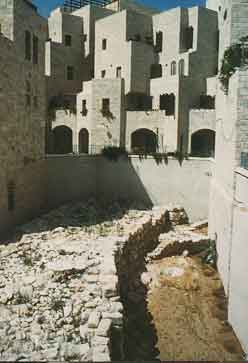 We rose about 6:30 a.m. and Bob jogged through the streets for two or three
miles and said he saw some interesting sights. We had breakfast in a lovely room overlooking a beautiful garden with masses of
fuchsia-colored flowers hanging over the wall, roses, and beautiful, weather-worn rocks surrounded by grass with palm trees in the background. Then, we checked out of the Hilton and into the Jerusalem
Towers to save some money and to be within
walking distance of the old city of Jerusalem. So then we took a walk. Most of what we saw had been restored and the streets were so clean you could eat off them. In fact, the area we went through that day was so clean and bright and
sparkly, it looked more like a section of Disney World.
We rose about 6:30 a.m. and Bob jogged through the streets for two or three
miles and said he saw some interesting sights. We had breakfast in a lovely room overlooking a beautiful garden with masses of
fuchsia-colored flowers hanging over the wall, roses, and beautiful, weather-worn rocks surrounded by grass with palm trees in the background. Then, we checked out of the Hilton and into the Jerusalem
Towers to save some money and to be within
walking distance of the old city of Jerusalem. So then we took a walk. Most of what we saw had been restored and the streets were so clean you could eat off them. In fact, the area we went through that day was so clean and bright and
sparkly, it looked more like a section of Disney World.
During our stroll, we saw very few people, but at sundown, with the Sabbath over, the
streets came alive and people literally burst out of their homes and the streets
with a carnival-like atmosphere. We had a no-frill basic dinner of chicken and rice and went to bed early.
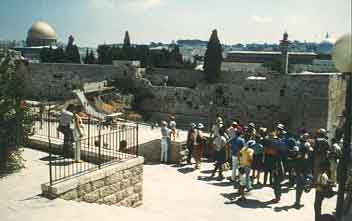
Sunday morning, we joined a tour group to see the Old City for a better appreciation of what we had seen the afternoon before. We also went through the Via
de la Rosa to see the Stations of the Cross, arriving at the Church of the Holy
Sepulcher. We walked past the Wailing Wall and up onto the Temple Mount. This is reportedly where Abraham was ordered to make a
sacrifice to God and all he had to sacrifice was his son until a lamb showed up and saved the day and the life of the son.
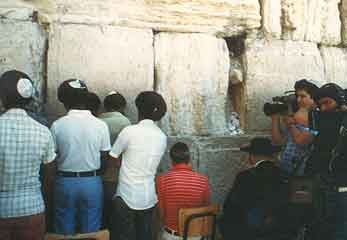
Israel's summer heat was sapping my strength, so I took a nap while Bob rented a car for the next day's
adventure and tried again to call Charlie and Trudy. This time he made contact with our
friends who had been at the Hilton for the preceding three days after all. We met them and had a wonderful dinner at Fefferbergs, around the corner from our hotel.
On Monday, we picked up the car and drove out to Yad Vashem, the memorial park dedicated to the
holocaust victims. I can't imagine any memorial done with more dignity and taste. There were several
buildings housing the museum, the
records of names of
victims, administration, etc., but the one that got to me most was a large, low-ceiling building, pitch black inside, with no light except baby
spots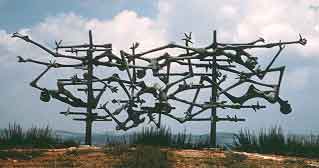 reflecting on white
placards showing the name of each concentration camp, set out on black carpet of nothingness. No other words were needed. reflecting on white
placards showing the name of each concentration camp, set out on black carpet of nothingness. No other words were needed.
Outside were gardens, a memorial to the children who died in the camps. There was the Pillar of Heroism with this inscription: "Now and forever in memory of those, who rebelled in the camps and ghettoes, fought in the woods, in the underground and
with the Allied Forces, who braved their way to Eretz Israel and those who died
sanctifying the name of God." The moderate-sized crowd moved silently through the complex, statues and memorials. Each person seemed to be alone with his or her thoughts. In that place,
at Yad Vashem, how could anyone visit there without going into
contemplation or meditation on man's inhumanity to man? How could this have happened? What were they thinking? What must we do to prevent this from ever happening again?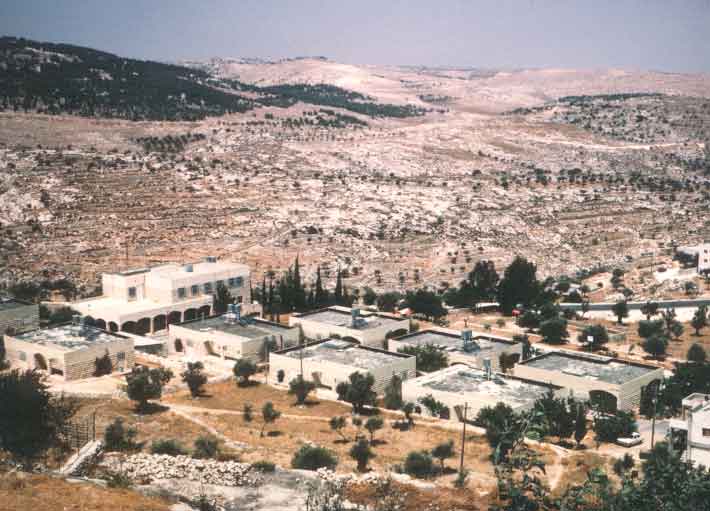
In early afternoon, we drove to Bethlehem through the very hilly countryside. The white rocks of this terrain were abundant and had been collected and laid out in squares. Were they the remains of house walls, or did the rocks designate the plots of a
burial ground, or gardens? We never learned the answer.
Bethlehem is an Arab town, but the Israeli government keeps it clean and the houses are the light-tan stone, typical of the housing in Jerusalem. The Church of the Nativity (supposedly built over the place where Jesus was born) has a rather interesting door. Look for it in Christmas
cards. Originally, the door
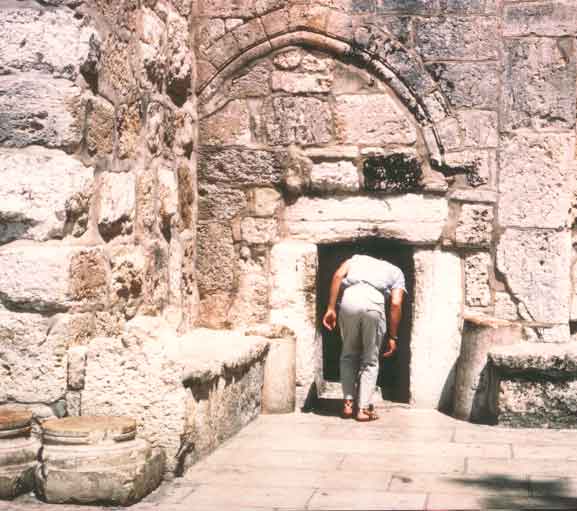 was a double arch, but one of the arches has been
completely bricked up with stone and the other arch has been half filled in at the top, so that one must bend over to enter, the opening being only about three feet in height. This was done soon after the church was
built to prevent desecrators from riding their horses in and doing ugly things to the interior. It was too dark in the church for me to take pictures, but I did get a shot of St. Hieronymous in the courtyard; a statue, of
course. was a double arch, but one of the arches has been
completely bricked up with stone and the other arch has been half filled in at the top, so that one must bend over to enter, the opening being only about three feet in height. This was done soon after the church was
built to prevent desecrators from riding their horses in and doing ugly things to the interior. It was too dark in the church for me to take pictures, but I did get a shot of St. Hieronymous in the courtyard; a statue, of
course.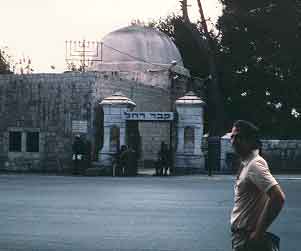
In route back to Jerusalem, we stopped at Rachael's Tomb, which had recently been desecrated and rebuilt. There were guards checking everyone's bags and purses at the entrance. Outside, atop a building across the street, were two Israeli military personnel with
uzzies stationed there and ready for an attack. It was so very sad to see that such precautions were necessary.
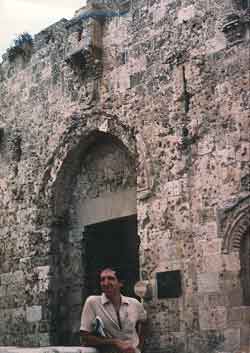
Back in Jerusalem, we returned to the old city and went through the original memorial to the
Holocaust Victims, and then next door to David's Tomb. Next, we wandered through the Gate of Zion with
its bullet holes from the 1948
independence uprising. Then, around the corner, we strolled past the Dormition Abby, claimed to be the original seat of Christianity. Back in the car, we drove up the Mt. of Olives, Mt. Scopus, through Hebrew University and back down to the city through an Arab suburb. Driving through this substandard suburb, you could see the anger and hostility in the eyes of even the young children. Later in the evening, we had fabulous pizza and beer with Charlie and Trudy at
Mama Mia's.
On Tuesday, we left most of our "stuff' at the hotel, packed only what we really needed for an overnight, and headed out for Jericho, the Dead Sea, En Gedi and
Massada. This became the strangest trip I have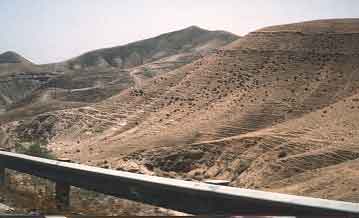 ever had in my life; never before, nor since, have I ever been afraid of simply driving down a road. About twenty minutes from the city, we were into the desolate,
barren, arid hills of Judea which soon turned into ominous mountains, and I began to develop a very real phobia to the entire scene. Perhaps it was the unfamiliar car, the narrow road, being the only car on the road, or a minor accident we had had back in the U.S. a year earlier, but I couldn't relax and sat stiff as a board all the way to Jericho. It only made matters
worse as we headed down toward the border town to see a caravan of military
vehicles leaving the border and passing us, going the other way. Did they know something we didn't know? ever had in my life; never before, nor since, have I ever been afraid of simply driving down a road. About twenty minutes from the city, we were into the desolate,
barren, arid hills of Judea which soon turned into ominous mountains, and I began to develop a very real phobia to the entire scene. Perhaps it was the unfamiliar car, the narrow road, being the only car on the road, or a minor accident we had had back in the U.S. a year earlier, but I couldn't relax and sat stiff as a board all the way to Jericho. It only made matters
worse as we headed down toward the border town to see a caravan of military
vehicles leaving the border and passing us, going the other way. Did they know something we didn't know?
Finally, it was a relief to arrive at Jericho. I got a picture of the Mount of
Temptation where Jesus fasted for forty days and was tempted by the devil. I felt it was highly improbable that Jesus experienced the heat we were experiencing
THAT day. Not for forty days, he didn't! 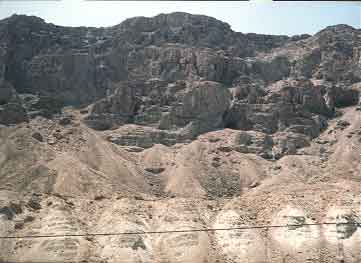 We had not stayed long at Jericho and were soon back on the road that paralleled the Dead
Sea at 1200 feet below sea level, and the mountains still seemed to threaten. With the Dead Sea on our left, the mountains on our right,
(the Qumran Hills where the Dead Sea Scrolls were discovered).
Sometimes they sat far back from the road and sometimes they came right down to the water and the road had to cut up into them. But always, they were old, cracked and crumbling, and the cracks were
sometimes slanted in such a way, that, when they slid off the mountains, they would fall on the
road and any passing car. In the meantime, I was tense again, all the way to the En Gedi
Beach where we stopped for gas and a new threat became apparent. The gas station, fairly new, had been built with no windows, and all the doors were of steel with heavy locks. Even the
alcove containing the trash had a steel gate with heavy locks. Why? Thieves or war?
We had not stayed long at Jericho and were soon back on the road that paralleled the Dead
Sea at 1200 feet below sea level, and the mountains still seemed to threaten. With the Dead Sea on our left, the mountains on our right,
(the Qumran Hills where the Dead Sea Scrolls were discovered).
Sometimes they sat far back from the road and sometimes they came right down to the water and the road had to cut up into them. But always, they were old, cracked and crumbling, and the cracks were
sometimes slanted in such a way, that, when they slid off the mountains, they would fall on the
road and any passing car. In the meantime, I was tense again, all the way to the En Gedi
Beach where we stopped for gas and a new threat became apparent. The gas station, fairly new, had been built with no windows, and all the doors were of steel with heavy locks. Even the
alcove containing the trash had a steel gate with heavy locks. Why? Thieves or war?
A half mile later, my mood began to lighten as we cut up into the hills and arrived at the En Gedi
Kibbuttz, an oasis of palm trees, grass and flowers. Later we learned this
kibbutz was an experimental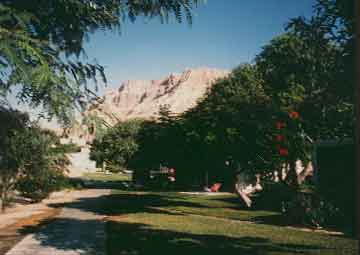 agricultural farm, which explained the profusion of plant and flower varieties. After checking into our room for a two-night stay, we went down to the En Gedi Hot Sulphur Springs
for a ten minute dip. Quite an experience! The water is so
buoyant, that, in order to keep yourself from flipping over in the pool, they have bars around the
sides to hold onto. They don't want you to stay in more than ten minutes and announce that anyone with a heart condition should stay out of the
pool altogether. The strain of holding yourself down in the water is apparently too
exhausting. agricultural farm, which explained the profusion of plant and flower varieties. After checking into our room for a two-night stay, we went down to the En Gedi Hot Sulphur Springs
for a ten minute dip. Quite an experience! The water is so
buoyant, that, in order to keep yourself from flipping over in the pool, they have bars around the
sides to hold onto. They don't want you to stay in more than ten minutes and announce that anyone with a heart condition should stay out of the
pool altogether. The strain of holding yourself down in the water is apparently too
exhausting.
We also spent another thirty minutes at the beach at the Dead Sea. Again, quite an experience! As I walked in water
only up to my ankles, I felt as though I would tip over if I went any deeper. It was like the sea was pushing you up and out. That is how high the saline
content is. While we were there, a woman sat down in the water in one of those low chairs that are only about six inches off the
ground in the water. Suddenly, she went running toward the bath house. One of her two friends turned to the other and asked what had happened. "Diaper rash!" was the reply.
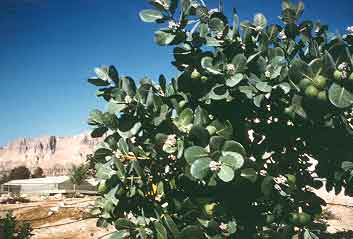 They served us a meatless, kosher dinner with yogurt and hot milk and it was great to have
salad and veggies again. The hot milk was also great, once it cooled. After dinner, we strolled
around the kibbutz and saw their miniature-golf course, badminton court, basketball
court and pool. The entire area was a garden encircled by a chain link
fence with
rolls of barbed wire across the top. On the other side of the fence was a cliff, which dropped perhaps a hundred feet or more to the valley below. At strategic locations were bunkers.
For all its beauty, this country is always alert to the fact of war.
They served us a meatless, kosher dinner with yogurt and hot milk and it was great to have
salad and veggies again. The hot milk was also great, once it cooled. After dinner, we strolled
around the kibbutz and saw their miniature-golf course, badminton court, basketball
court and pool. The entire area was a garden encircled by a chain link
fence with
rolls of barbed wire across the top. On the other side of the fence was a cliff, which dropped perhaps a hundred feet or more to the valley below. At strategic locations were bunkers.
For all its beauty, this country is always alert to the fact of war.
Back at the room we had hoped to cool off, but the air conditioning wasn't working, so we sat outside and looked at the Dead
Sea until the sun set and it turned dark. When we entered the room and turned on the light, we viewed the most horrible
sight -- cockroaches the size of small mice -- everywhere -- on the walls, the floor, the ceiling. Bob killed about
five before they scurried away. I pulled my cot into the center of the room, and as hot as it was, we left the lights on and I pulled the sheet over my head.. .all night. We would not be spending a second night there.
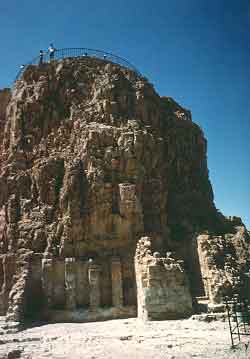
On Wednesday morning, we left En Gedi Kibbutz, and forged on to Massada. A few years following the death of Jesus, King Herod, being a bit paranoid about his position, caught between the Jewish population
(which did not like him) and the Roman Militia (which merely
tolerated him), built a palace retreat complex at the top of a very high butte and called it Massada. An earthquake destroyed his beautiful palaces and, therefore, he never moved there.
Later during the time of the Jewish uprising, a little community of Jews retreated
there rather than face the consequences of being captured by Romans.
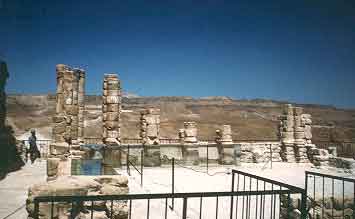 They had water and food, and were able to hold out for three years, as the Romans
built an enormous ramp up the side of the mountain.
In the end, 961 died rather than be taken prisoner. They had water and food, and were able to hold out for three years, as the Romans
built an enormous ramp up the side of the mountain.
In the end, 961 died rather than be taken prisoner.
There was much to see, and we stayed about three hours exploring little nooks and crannies, and marveling over the beautiful mosaics that still remain in some places. The heat was insufferable but I wouldn't have missed a minute.
A truly
awesome experience.
Back in Jerusalem, we picked up the bags we had left behind, checked into the Shoresh
Kibbuttz, and had a much needed swim in their pool. At our room, we were greeted by a little
snake sleeping on our doorstep. When we went to bed, we put towels under the door to make
sure he stayed outside during the night. We also checked everywhere in the room to make sure none of his relatives preferred to be indoors.
If you are traveling on your own in Israel, you must always keep track of the day of the
week because everything closes down on the
Sabbath (Friday sundown to Saturday sundown). So on Thursday morning, we left
the Shoresh
Kibbutz 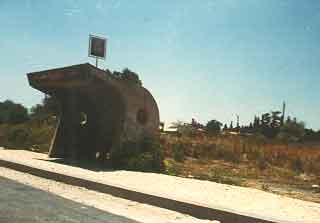 and Jerusalem area, making our goal for the day
Nof Ginosar on the Sea of Galilie. We drove toward Tel Aviv through countryside that looked much like our
Midwest, past Gen Gourion Airport, through Petah Tikva, Kfar Saba, and Herzlia. We stopped to see the beach and the Mediterranean from the Sharon Hotel in Herzlia. Later on, up the road, we stopped at the kibbutz, Shefayim, which was bubbling with much tourist activity. Then, we went through Netanya, Hadera, over the southern mountain
range of which Mt. Cannel is a part, through the Yizreel Valley, over the Kishou
River through Afula and on to Nazareth.
and Jerusalem area, making our goal for the day
Nof Ginosar on the Sea of Galilie. We drove toward Tel Aviv through countryside that looked much like our
Midwest, past Gen Gourion Airport, through Petah Tikva, Kfar Saba, and Herzlia. We stopped to see the beach and the Mediterranean from the Sharon Hotel in Herzlia. Later on, up the road, we stopped at the kibbutz, Shefayim, which was bubbling with much tourist activity. Then, we went through Netanya, Hadera, over the southern mountain
range of which Mt. Cannel is a part, through the Yizreel Valley, over the Kishou
River through Afula and on to Nazareth.
From the road we were on, we could see Nazareth over on the other mountain range with a valley between us. It is an Arab (mostly)
village nestled among a dozen or so steep hills reminiscent of the hills
of West Virginia, except there are no trees. The roads are winding with hairpin turns and blind curves, and the locals seem to think nothing of passing two or three cars at a time on these blind curves. "Doesn't this cause a lot of accidents?" you may ask. You BET it does, and the proof is the entire area is littered with several hundred cars that have gone off the road and down the mountains. Most of these cars remain on the hillsides where they stopped rolling. Many have been removed to the
dump areas in peoples' back yards. I was mighty glad to finally be out of the area. But, even on the "straight-away", it's scary on those two lane highways to see a car from the "on-coming"
traffic pull out into your lane to pass and come straight toward you.
What a beautiful sight to see the blue-green waters of the Sea of Galilee and arrive at a semi-modern Tiberias on the coast. The constant, strong wind that comes down out of the mountains toward the
sea causes all the trees to lean oddly toward the sea. It is a rather peculiar
sight when one is accustomed to seeing trees leaning away from the Pacific on our West Coast.
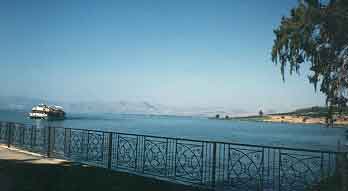
Up the coast from Tiberius, we checked into our next kibbutz, Nof Ginosar, which had the softest beds since the Jerusalem Hilton. It was very hot when we arrived and the very wind itself was hot. Bob thought it was hotter than at Massada, but they had a lovely little park that went right down to the beach, so he went down for his swim in the Sea of Galilee. I was too exhausted from the heat to walk the couple of blocks to the Sea, so I stayed in the room and relaxed.
Within a 36-hour period, we had gone from 1,200 feet below sea level at the Dead Sea beach near the En Gedi Kibuttz, to 2,200 feet above sea level at Shoreoh Kibbutz and at Nof Ginosar we went back down to 680 feet. Unbelievable! At En Gedi, we had large roaches, at Shoreoh we dealt with snakes, and at
Nof Ginosar is was lizards. Truly unbelievable! The first one we saw had to be at least 8 inches long and he was sitting on the outside of our
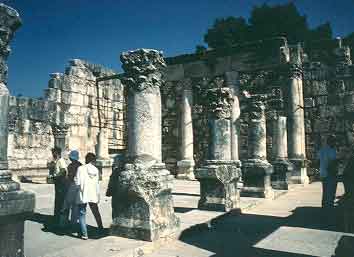 window screen. Well, he was the granddaddy, because all the others, perhaps 50 or 60, were much smaller but were covering our door when we returned from dinner and a slide show on the history of the kibbutz. window screen. Well, he was the granddaddy, because all the others, perhaps 50 or 60, were much smaller but were covering our door when we returned from dinner and a slide show on the history of the kibbutz.
Friday was fabulous! Well, at least it started out that way. We first had a quick little stop at Tabgha to see the beautiful mosaic tiles in the floor of the Church of the Multiplication of Loaves and Fishes, dating back to the sixth century. The mosaics depicted the birds and foul of the area
at that time. A truly "not-to-be-missed" stop.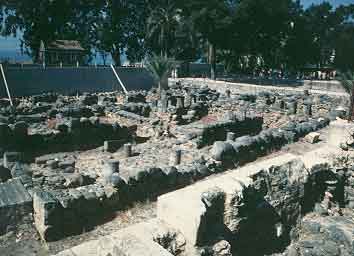
Next, we went on down the road to Capernaum to visit the third-century synagogue built on the ruins of the
synagogue that was there during the time of Jesus. It was of Roman architecture and now in ruins, but it was directly across the narrow street from Peter's
House: Peter's House was where Jesus stayed while in town and said to be the first "Christian
Church." From a non-archeologist's point of view, there was not a lot to see there. The foundation of black rocks only seemed to outline the rooms of the house...but still...
Before leaving Jerusalem we had been told the story of tourists, like us, driving alone, like us,
who had picked up what appeared to be an Israeli Soldier, hitch hiking on one of the lonely back
roads like we were on. He turned out NOT to be an Israeli soldier, and he
took their car, their bags and left them standing along the side of the road. We had been warned to "watch
out." So, when we stopped the car to
look at a map, and another car stopped and a man wearing an Israeli uniform and carrying a
gun got out and walked over to my side of the car to help us, I nearly went into cardiac arrest. Bob was entirely too slow in responding, "no thank you" and he came right up beside my door, put his hand on the door to try to open it. Fortunately, I had it locked, and looked straight ahead, and through clinched teeth, I kept saying to Bob, "drive on, drive on, tell him we are OK and drive
on -- for God's sake, GET US THE HELL OUT OF HERE." Bob just sat there and gawked, but I kept looking straight ahead and wouldn't open the door. Finally, Mr. B got the message and did just that, but by THAT time I had become a basket
case and remained so for the rest of the day. (Bob would probably tell a different story, but we aren't
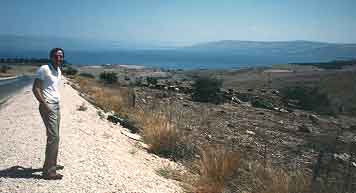 asking him) asking him)
Our adventure was not over by a long shot. We drove on and on through desolate
countryside -- no people, no animals, no trees, no nothing -- just rocky
terrain. Occasionally, we would see a road sign. At first, the road signs were in three languages, English, Israeli, and Arabic. Then, they dropped the English from the signs. Finally, they dropped another language, but Bob couldn't tell which one, and I, certainly, didn't have a clue. We knew we HAD to be near the
border. We passed an Israeli Military Camp and there were soldiers right beside the road. We could have asked
directions -- Bob wouldn't stop. We drove on and on and on. We passed a long deserted farm house in the middle of a hairpin curve. I could see chunks of the walls had been broken out from gunfire. I had visions of the headline of a newspaper reading, "American couple stupidly crossed
border into enemy territory -- and will never be seen again." We drove on and on and on.
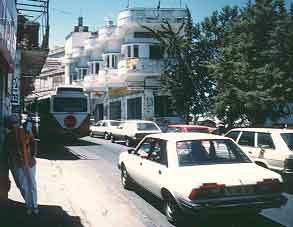
Finally, after what seemed like hours, we found a sign with "Rosh Pina and Safed" on it. "Just what we are looking
for," Bob said. I didn't reply. I was catatonic.
We left Nof Ginosar Saturday morning after breakfast. We drove through the hills of Galilee to Akko, Nahariya, and finally on to
Haifa, up into Mt. Cannel, looking for the hotel where we had reservations for the night, but never found it. So, we continued on to
Hof Dor, a lovely little kibbutz right on the ocean. We stayed there for two nights, swam in the Mediterranean, rested, relaxed, and
recovered -- a delightful place I would return to in a heartbeat.
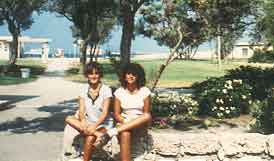 Security was tight at Gen Gurean Airport on Tuesday morning. There had been a highjacking
and a bomb blast in the Paris customs office the week before. My gold bangles set off the
alarm going through the gate, and the guards came running from everywhere --
very embarrassing. But, it had been a great trip and I'll never forget it. Some day, I vowed, I shall return.
Security was tight at Gen Gurean Airport on Tuesday morning. There had been a highjacking
and a bomb blast in the Paris customs office the week before. My gold bangles set off the
alarm going through the gate, and the guards came running from everywhere --
very embarrassing. But, it had been a great trip and I'll never forget it. Some day, I vowed, I shall return.
THINK GLOBALLY - ACT LOCALLY - PRAY FOR WORLD PEACE
|
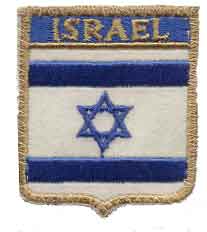


 through
customs, we had our passports stamped and were given maps, and travel brochures, and a warm, welcoming smile by a lovely young Israeli woman at the
border. Our luggage was placed on a new, clean, modern, AIR-CONDITIONED bus and the first thing I did upon
arriving was to order a glass of water, which I hadn't been able to do for the past three weeks in Egypt. The building, itself, was such a contrast to the Egyptian side of the
border, with its painted floors and clean walls, and the knowledge we could now order food and drink without having to worry about coming down with the Pharaoh's Curse. We were surrounded by green grass and flowers, BEAUTIFUL flowers, in a variety of colors.. .a long time since we had seen anything like it.
through
customs, we had our passports stamped and were given maps, and travel brochures, and a warm, welcoming smile by a lovely young Israeli woman at the
border. Our luggage was placed on a new, clean, modern, AIR-CONDITIONED bus and the first thing I did upon
arriving was to order a glass of water, which I hadn't been able to do for the past three weeks in Egypt. The building, itself, was such a contrast to the Egyptian side of the
border, with its painted floors and clean walls, and the knowledge we could now order food and drink without having to worry about coming down with the Pharaoh's Curse. We were surrounded by green grass and flowers, BEAUTIFUL flowers, in a variety of colors.. .a long time since we had seen anything like it. hotel clerk told us their group was in Haifa. Later we were to discover this was not true and they were in the hotel all along. Anyway, they found a little room for us and, having had no sleep since leaving Cairo, we crashed about 4:45
p.m. and slept until 9:00 p.m., when we dressed, went down to dinner and--
oops, it's Friday evening, (Sabbath) and they don't heat the grill on Sabbath. That's OK. We
hadn't had salads in three weeks, so we ordered tuna salads and they were the largest I've ever seen. They had green beans, potatoes, tuna, onions, olives, tomatoes,
anchovies, and lettuce. I also had a delicious glass of milk and about four glasses
of ice water. The salad was so large I couldn't finish it.
hotel clerk told us their group was in Haifa. Later we were to discover this was not true and they were in the hotel all along. Anyway, they found a little room for us and, having had no sleep since leaving Cairo, we crashed about 4:45
p.m. and slept until 9:00 p.m., when we dressed, went down to dinner and--
oops, it's Friday evening, (Sabbath) and they don't heat the grill on Sabbath. That's OK. We
hadn't had salads in three weeks, so we ordered tuna salads and they were the largest I've ever seen. They had green beans, potatoes, tuna, onions, olives, tomatoes,
anchovies, and lettuce. I also had a delicious glass of milk and about four glasses
of ice water. The salad was so large I couldn't finish it.